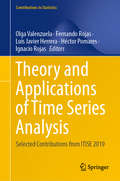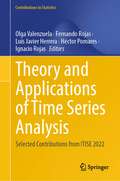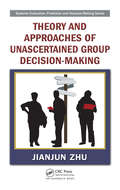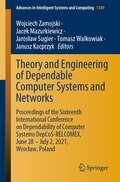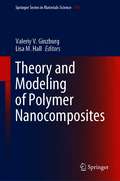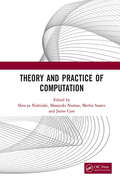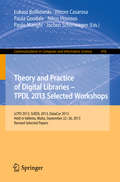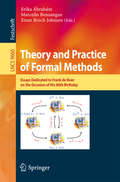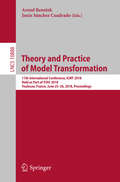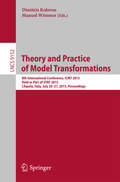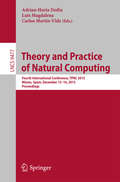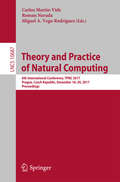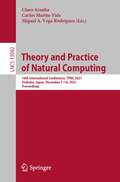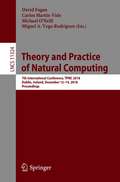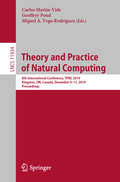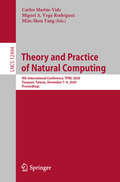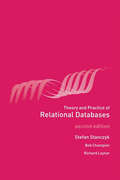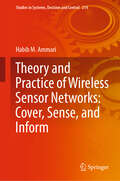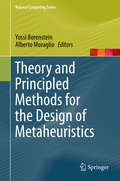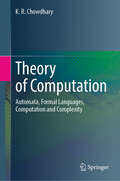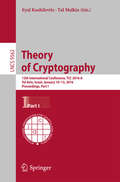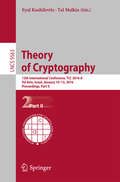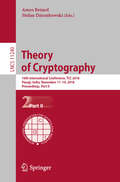- Table View
- List View
Theory and Applications of Time Series Analysis: Selected Contributions from ITISE 2019 (Contributions to Statistics)
by Ignacio Rojas Héctor Pomares Olga Valenzuela Fernando Rojas Luis Javier HerreraThis book presents a selection of peer-reviewed contributions on the latest advances in time series analysis, presented at the International Conference on Time Series and Forecasting (ITISE 2019), held in Granada, Spain, on September 25-27, 2019. The first two parts of the book present theoretical contributions on statistical and advanced mathematical methods, and on econometric models, financial forecasting and risk analysis. The remaining four parts include practical contributions on time series analysis in energy; complex/big data time series and forecasting; time series analysis with computational intelligence; and time series analysis and prediction for other real-world problems. Given this mix of topics, readers will acquire a more comprehensive perspective on the field of time series analysis and forecasting.The ITISE conference series provides a forum for scientists, engineers, educators and students to discuss the latest advances and implementations in the foundations, theory, models and applications of time series analysis and forecasting. It focuses on interdisciplinary research encompassing computer science, mathematics, statistics and econometrics.
Theory and Applications of Time Series Analysis: Selected Contributions from ITISE 2022 (Contributions to Statistics)
by Ignacio Rojas Héctor Pomares Olga Valenzuela Fernando Rojas Luis Javier HerreraThis book presents the latest developments in the theory and applications of time series analysis and forecasting. Comprising a selection of refereed papers, it is divided into several parts that address modern theoretical aspects of time series analysis, forecasting and prediction, with applications to various disciplines, including econometrics and energy research. The broad range of topics discussed, including matters of particular relevance for sustainable development, will give readers a modern perspective on the subject.The included contributions were originally presented at the 8th International Conference on Time Series and Forecasting, ITISE 2022, held in Gran Canaria, Spain, June 27-30, 2022. The ITISE conference series provides a forum for scientists, engineers, educators and students to discuss the latest advances and implementations in the foundations, theory, models and applications of time series analysis and forecasting. It focuses on interdisciplinary research encompassing computer science, mathematics, statistics and econometrics.
Theory and Approaches of Unascertained Group Decision-Making (Systems Evaluation, Prediction, And Decision-making Ser.)
by Jianjun ZhuTackling the question of how to effectively aggregate uncertain preference information in multiple structures given by decision-making groups, Theory and Approaches of Unascertained Group Decision-Making focuses on group aggregation methods based on uncertainty preference information. It expresses the complexity existing in each group decision-maki
Theory and Engineering of Dependable Computer Systems and Networks: Proceedings of the Sixteenth International Conference on Dependability of Computer Systems DepCoS-RELCOMEX, June 28 – July 2, 2021, Wrocław, Poland (Advances in Intelligent Systems and Computing #1389)
by Janusz Kacprzyk Wojciech Zamojski Jacek Mazurkiewicz Jarosław Sugier Tomasz WalkowiakThis book contains papers on selected aspects of dependability analysis in computer systems and networks, which were chosen for discussion during the 16th DepCoS-RELCOMEX conference held in Wrocław, Poland, from June 28 to July 2, 2021. Their collection will be a valuable source material for scientists, researchers, practitioners and students who are dealing with design, analysis and engineering of computer systems and networks and must ensure their dependable operation.Being probably the most complex technical systems ever engineered by man (and also—the most dynamically evolving ones), organization of contemporary computer systems cannot be interpreted only as structures built on the basis of (unreliable) technical resources. Their evaluation must take into account a specific blend of interacting people (their needs and behaviours), networks (together with mobile properties, cloud organization, Internet of Everything, etc.) and a large number of users dispersed geographically and constantly producing an unconceivable number of applications. Ever-growing number of research methods being continuously developed for dependability analyses apply the newest techniques of artificial and computational intelligence. Selection of papers in these proceedings illustrates diversity of multi-disciplinary topics which are considered in present-day dependability explorations.
Theory and Modeling of Polymer Nanocomposites (Springer Series in Materials Science #310)
by Valeriy V. Ginzburg Lisa M. HallThis edited volume brings together the state of the art in polymer nanocomposite theory and modeling, creating a roadmap for scientists and engineers seeking to design new advanced materials. The book opens with a review of molecular and mesoscale models predicting equilibrium and non-equilibrium nanoscale structure of hybrid materials as a function of composition and, especially, filler types. Subsequent chapters cover the methods and analyses used for describing the dynamics of nanocomposites and their mechanical and physical properties. Dedicated chapters present best practices for predicting materials properties of practical interest, including thermal and electrical conductivity, optical properties, barrier properties, and flammability. Each chapter is written by leading academic and industrial scientists working in each respective sub-field. The overview of modeling methodology combined with detailed examples of property predictions for specific systems will make this book useful for academic and industrial practitioners alike.
Theory and Practice of Computation: Proceedings of the Workshop on Computation: Theory and Practice (WCTP 2019), September 26-27, 2019, Manila, The Philippines
by Shin-Ya NishizakiThis book provides a collection of papers from the Ninth Workshop on Computing: Theory and Practice, WCTP 2019 devoted to theoretical and practical approaches to computation, which was organized by four top universities in Japan and the Philippines: Tokyo Institute of Technology, Osaka University, the University of the Philippines Diliman, and De La Salle University. The proceedings provide a broad overview of recent research trends in computer science research in Asia, particularly in these two countries. The papers included in the proceedings focus on both theoretical and practical aspects of computations, such as programming language theory, modeling of software systems, applications of machine learning, empathic computing, and various applications of information technology.
Theory and Practice of Digital Libraries -- TPDL 2013 Selected Workshops
by Łukasz Bolikowski Vittore Casarosa Paula Goodale Nikos Houssos Paolo Manghi Jochen SchirrwagenThis book constitutes the refereed proceedings of the selected workshops co-located with the 17th International Conference on Theory and Practice of Digital Libraries, TPDL 2013, held in Valletta, Malta, in September 2013. The volume is organized in three parts, containing the 26 revised full papers of the three workshops: Linking and Contextualizing Publications and Datasets (LCPD 2013); Supporting Users Exploration of Digital Libraries (SUEDL 2013); Moving beyond technology: iSchools and education in data curation. Is Data Curator a new role? (DataCur 2013).
Theory and Practice of Digital Libraries -- TPDL 2013 Selected Workshops: LCPD 2013, SUEDL 2013, DataCur 2013, Held in Valletta, Malta, September 22-26, 2013. Revised Selected Papers (Communications in Computer and Information Science #416)
by Łukasz Bolikowski, Vittore Casarosa, Paula Goodale, Nikos Houssos, Paolo Manghi and Jochen SchirrwagenThis book constitutes the refereed proceedings of the selected workshops co-located with the 17th International Conference on Theory and Practice of Digital Libraries, TPDL 2013, held in Valletta, Malta, in September 2013. The volume is organized in three parts, containing the 26 revised full papers of the three workshops: Linking and Contextualizing Publications and Datasets (LCPD 2013); Supporting Users Exploration of Digital Libraries (SUEDL 2013); Moving beyond technology: iSchools and education in data curation. Is Data Curator a new role? (DataCur 2013).
Theory and Practice of Formal Methods
by Einar Broch Johnsen Erika Ábrahám Marcello BonsangueThis Festschrift volume has been published in honor ofFrank de Boer, on the occasion of his 60th birthday. Frank S. de Boer is a prominent member of the research community in formalmethods and theoretical computer science. A brief look at his lengthypublication list reveals a broad area of interest and a versatile modusoperandi with: logic and constraint programming; deductive proof systems,soundness, and completeness; semantics, compositionality, and full abstraction;process algebra and decidability; multithreading and actor-based concurrency;agent programming, ontologies, and modal logic; real-time systems, timedautomata, and schedulability; enterprise architectures, choreography, andcoordination; testing and runtime monitoring; and cloud computing and service-levelagreements. For a while, he also liked failures, especially in semantics, andoptimistically concluded with the failure of failures. In fact, Frank has anopportunistic approach to research. Rather than seeing obstacles, he findsopportunities.
Theory and Practice of Model Transformation: 11th International Conference, ICMT 2018, Held as Part of STAF 2018, Toulouse, France, June 25–26, 2018, Proceedings (Lecture Notes in Computer Science #10888)
by Arend Rensink Jesús Sánchez CuadradoThis book constitutes the refereed proceedings of the 11th International Conference on Model Transformation, ICMT 2018, held as part of STAF 2018, in Toulouse, France, in June 2018.The 9 full papers were carefully reviewed and selected from 24 submissions. This book also presents 1 invited paper. The papers include research, application, and tool demonstration papers presented in the context of four sessions on verification of model transformations, model transformation tools, transformation reuse and graph transformations.
Theory and Practice of Model Transformations
by Dimitris Kolovos Manuel WimmerThis book constitutes the refereed proceedings of the 8th International Conference on Model Transformation, ICMT 2015, held in L'Aquila, Italy, in July 2015, as Part of STAF 2015, the federation of a number of the leading conferences on software technologies. The 16 revised papers were carefully selected from 34 submissions. The papers are organized in topical sections on change management; reuse and industrial applications; new paradigms for model transformation; transformation validation and verification; and foundations of model transformation.
Theory and Practice of Model Transformations
by Pieter Van Gorp Gregor EngelsThis book constitutes the refereed proceedings of the 9th International Conference on Model Transformation, ICMT 2016, held in Vienna, Austria, in July 2016, as Part of STAF 2015, the federation of a number of the leading conferences on software technologies. The 13 revised papers were carefully selected from 36 submissions. The papers are organized in topical sections on model transformation languages, model transformation tools, developing model transformations, applications of model transformations, and looking ahead.
Theory and Practice of Natural Computing
by Carlos Martín-Vide Adrian-Horia Dediu Luis MagdalenaThis book constitutes the refereed proceedings of the 4thInternational Conference on Theory and Practice of Natural Computing, TPNC2015, held in Mieres, Spain, in December 2015. The 12 revised full papers presented togetherwith 20 invited talks in this book were carefully reviewed and selected from 30submissions. The scope of TPNC is rather broad, containing topics of eithertheoretical, experimental or applied interest such as soft computing, computingarchitectures, and formal models.
Theory and Practice of Natural Computing
by Carlos Martín-Vide Miguel A. Vega-Rodríguez Roman NerudaThis book constitutes the refereed proceedings of the 6th International Conference,on Theory and Practice of Natural Computing, TPNC 2017, held in Prague, Czech Republic, December 2017.The 22 full papers presented in this book, together with one invited talk, werecarefully reviewed and selected from 39 submissions. The papers are organized around the following topical sections: applications of natural computing; evolutionary computation; fuzzy logic; Molecular computation; neural networks; quantum computing.
Theory and Practice of Natural Computing: 10th International Conference, TPNC 2021, Virtual Event, December 7–10, 2021, Proceedings (Lecture Notes in Computer Science #13082)
by Carlos Martín-Vide Miguel A. Vega-Rodríguez Claus AranhaThis book constitutes the refereed proceedings of the 10th International Conference on Theory and Practice of Natural Computing, TPNC 2021, held virtually, in December 2021. The 9 full papers presented together with 3 invited talks, in this book were carefully reviewed and selected from 14 submissions. The papers are organized in topical sections named Applications of Natural Computing, Deep Learning and Transfer Learning, Evolutionary and Swarm Algorithms.
Theory and Practice of Natural Computing: 7th International Conference, TPNC 2018, Dublin, Ireland, December 12–14, 2018, Proceedings (Lecture Notes in Computer Science #11324)
by Michael O'Neill Carlos Martín-Vide Miguel A. Vega-Rodríguez David FaganThis book constitutes the refereed proceedings of the 7th International Conference on Theory and Practice of Natural Computing, TPNC 2017, held in Dublin, Ireland, in December 2018. The 35 full papers presented in this book, together with one invited talk, were carefully reviewed and selected from 69 submissions. The papers are organized around the following topical sections: applications of natural computing as algorithms, bioinformatics, control, cryptography, design, economics. The more theoretical contributions handle with artificial chemistry, artificial immune systems, artificial life, cellular automata, cognitive computing, cognitive engineering, cognitive robotics, collective behaviour, complex systems, computational intelligence, computational social science, computing with words, developmental systems, DNA computing, DNA nanotechnology, evolutionary algorithms, evolutionary computing, evolutionary game theory, fractal geometry, fuzzy control, fuzzy logic, fuzzy sets, fuzzy systems, genetic algorithms, genetic programming, granular computing, heuristics, intelligent agents, intelligent systems, machine intelligence, molecular programming, neural computing, neural networks, quantum communication, quantum computing, rough sets, self-assembly.
Theory and Practice of Natural Computing: 8th International Conference, TPNC 2019, Kingston, ON, Canada, December 9–11, 2019, Proceedings (Lecture Notes in Computer Science #11934)
by Carlos Martín-Vide Miguel A. Vega-Rodríguez Geoffrey PondThis book constitutes the refereed proceedings of the 8th International Conference on Theory and Practice of Natural Computing, TPNC 2019, held in Kingston, ON, Canada, in December 2019. The 15 full papers presented in this book, together with two invited talk, were carefully reviewed and selected from 38 submissions. The papers are organized in topical sections named: Applications of Natural Computing; Evolutionary Computation; Genetic Algorithms, Swarm Intelligence, and Heuristics; Quantum Computing and Information.
Theory and Practice of Natural Computing: 9th International Conference, TPNC 2020, Taoyuan, Taiwan, December 7–9, 2020, Proceedings (Lecture Notes in Computer Science #12494)
by Carlos Martín-Vide Miguel A. Vega-Rodríguez Miin-Shen YangThis book constitutes the refereed proceedings of the 9th International Conference on Theory and Practice of Natural Computing, TPNC 2020, held in Taoyuan, Taiwan, in December 2020. The 12 full papers presented in this book, together with one invited talk, were carefully reviewed and selected from 24 submissions. The papers are organized in topical sections named: applications of natural computing; quantum computing and unconventional computing; and swarm intelligence, evolutionary algorithms, and DNA computing.
Theory and Practice of Relational Databases
by Bob Champion Stefan Stanczyk Richard LeytonThe study of relationship databases is a core component of virtually every undergraduate computer science degree course. This new edition of Theory and Practice of Relationship Databases retains all the features that made the previous edition such as success, and goes on to give even more comprehensive and informative coverage.Written in a tutorial style and containing a great many examples and exercises as well as extensively using illustrative and explanatory graphics, the author has produced an undergraduate textbook of great depth and clarity that is very easy to follow. The subject of relational databases is brought to life by the writing style and the inclusion of an homogenous case study that reinforces the issues dealt with in each chapter.The primary objective of the book is to present a comprehensive explanation of the process of development of database application systems within the framework of a set processing paradigm. Since the majority of these applications are built as relationship systems, a complete though reasonably concise account of that model is presented. Dr. Stanczyk has achieved this by concentrating on the issues that contribute significantly to the application development while de-emphasizing purely theoretical aspects of the subject. This has led to an imaginative and highly practical textbook that will be an excellent read for the undergraduate computer science student.
Theory and Practice of Wireless Sensor Networks: Cover, Sense, and Inform (Studies in Systems, Decision and Control #214)
by Habib M. AmmariThis book aims at developing a reader’s thorough understanding of the challenges and opportunities of two categories of networks, namely k-covered wireless sensor networks and k-barrier covered wireless sensor networks. It presents a variety of theoretical studies based on percolation theory, convexity theory, and applied computational geometry, as well as the algorithms and protocols that are essential to their design, analysis, and development. Particularly, this book focuses on the cover, sense, and inform (CSI) paradigm with a goal to build a unified framework, where connected k-coverage (or k-barrier coverage), sensor scheduling, and geographic data forwarding, gathering, and delivery are jointly considered. It provides the interested reader with a fine study of the above networks, which can be covered in introductory and advanced courses on wireless sensor networks. This book is useful to senior undergraduate and graduate students in computer science, computer engineering, electrical engineering, information science, information technology, mathematics, and any related discipline. Also, it is of interest to computer scientists, researchers, and practitioners in academia and industry with interest in these two networks from their deployment until data gathering and delivery.
Theory and Principled Methods for the Design of Metaheuristics
by Yossi Borenstein Alberto MoraglioMetaheuristics, and evolutionary algorithms in particular, are known to provide efficient, adaptable solutions for many real-world problems, but the often informal way in which they are defined and applied has led to misconceptions, and even successful applications are sometimes the outcome of trial and error. Ideally, theoretical studies should explain when and why metaheuristics work, but the challenge is huge: mathematical analysis requires significant effort even for simple scenarios and real-life problems are usually quite complex. In this book the editors establish a bridge between theory and practice, presenting principled methods that incorporate problem knowledge in evolutionary algorithms and other metaheuristics. The book consists of 11 chapters dealing with the following topics: theoretical results that show what is not possible, an assessment of unsuccessful lines of empirical research; methods for rigorously defining the appropriate scope of problems while acknowledging the compromise between the class of problems to which a search algorithm is applied and its overall expected performance; the top-down principled design of search algorithms, in particular showing that it is possible to design algorithms that are provably good for some rigorously defined classes; and, finally, principled practice, that is reasoned and systematic approaches to setting up experiments, metaheuristic adaptation to specific problems, and setting parameters. With contributions by some of the leading researchers in this domain, this book will be of significant value to scientists, practitioners, and graduate students in the areas of evolutionary computing, metaheuristics, and computational intelligence.
Theory of Computation: Automata, Formal Languages, Computation and Complexity
by K.R. ChowdharyThis book offers a fresh perspective on the study and teaching of the Theory of Computation. The author's selection of topics and the comprehensive set of questions demonstrate extensive knowledge and years of experience in both teaching and research. It addresses practical aspects of computing models that are often overlooked. The book's emphasis on pedagogy, through carefully crafted exercises and clear elucidation of learning outcomes and chapter summaries, is a refreshing approach to the subject. With the right platform, this book has the potential to be adopted as a textbook in universities worldwide. The book covers new developments not typically addressed in other texts on the subject, such as algebraic theory, new applications of finite automata and regular languages, and topics from compiler theory that are closely related. It also explores several new relationships among models, with a natural progression of chapters. Key strengths of this book include its coverage of contemporary and relevant topics, practical applications of theoretical concepts, an extended Chomsky Hierarchy, and discussions on decidability, undecidability, and unsolvability. The book is tailored for its intended audience, with selected chapters suitable for undergraduate B.Tech./B.E. computer science students. Additionally, Chapters 9–14 can be used for a course on "Advanced Topics in Theory of Computer Science" at the Master's level (M.E./M.Tech.). It also serves as a foundational resource for those engaged in research in computer science.
Theory of Cryptography
by Tal Malkin Eyal KushilevitzThe two-volume set LNCS 9562 and LNCS 9563 constitutes the refereed proceedings of the 13th International Conference on Theory of Cryptography, TCC 2016, held in Tel Aviv, Israel, in January 2016. The 45 revised full papers presented were carefully reviewed and selected from 112 submissions. The papers are organized in topical sections on obfuscation, differential privacy, LWR and LPN, public key encryption, signatures, and VRF, complexity of cryptographic primitives, multiparty computation, zero knowledge and PCP, oblivious RAM, ABE and IBE, and codes and interactive proofs. The volume also includes an invited talk on cryptographic assumptions.
Theory of Cryptography
by Tal Malkin Eyal KushilevitzThe two-volume set LNCS 9562 and LNCS 9563 constitutes the refereed proceedings of the 13th International Conference on Theory of Cryptography, TCC 2016, held in Tel Aviv, Israel, in January 2016. The 45 revised full papers presented were carefully reviewed and selected from 112 submissions. The papers are organized in topical sections on obfuscation, differential privacy, LWR and LPN, public key encryption, signatures, and VRF, complexity of cryptographic primitives, multiparty computation, zero knowledge and PCP, oblivious RAM, ABE and IBE, and codes and interactive proofs. The volume also includes an invited talk on cryptographic assumptions.
Theory of Cryptography: 16th International Conference, TCC 2018, Panaji, India, November 11–14, 2018, Proceedings, Part II (Lecture Notes in Computer Science #11240)
by Amos Beimel Stefan DziembowskiThe two-volume set of LNCS 11239 and LNCS 11240 constitutes the revised proceedings of the 16th International Conference on Theory of Cryptography, TCC 2018, held in Panaji, India, in November 2018.The total of 50 revised full papers presented in the proceedings were carefully reviewed and selected from 168 submissions. The Theory of Cryptography Conference deals with the paradigms, approaches, and techniques used to conceptualize natural cryptographic problems and provide algorithmic solutions to them and much more.
